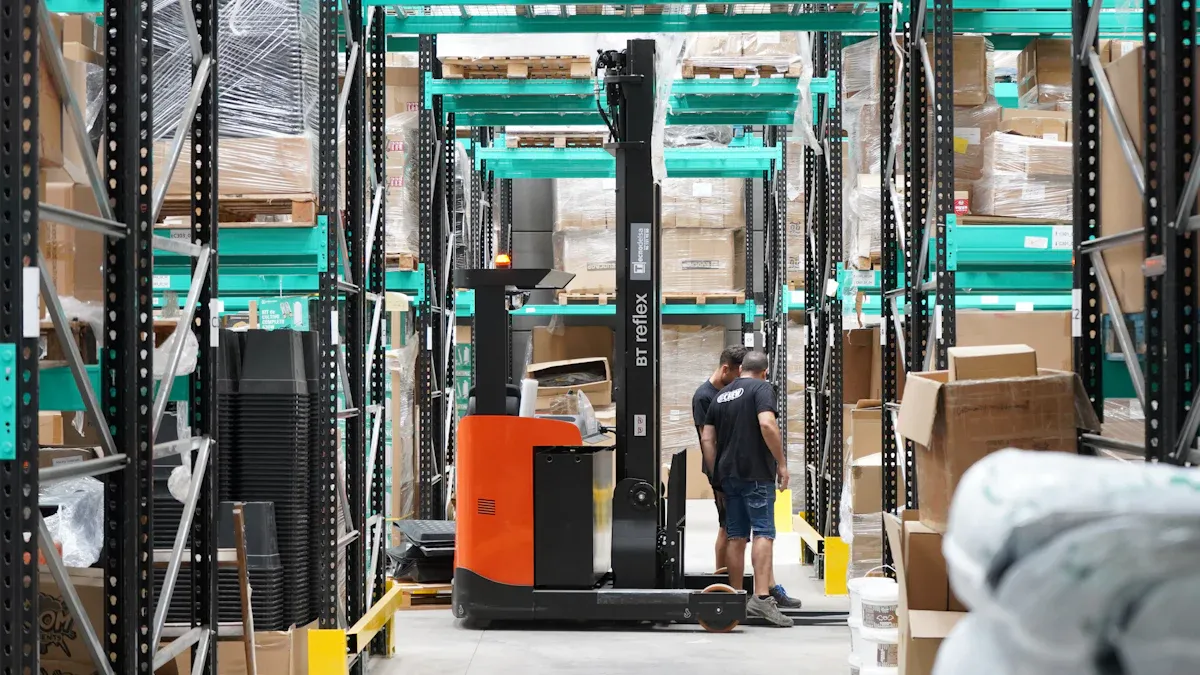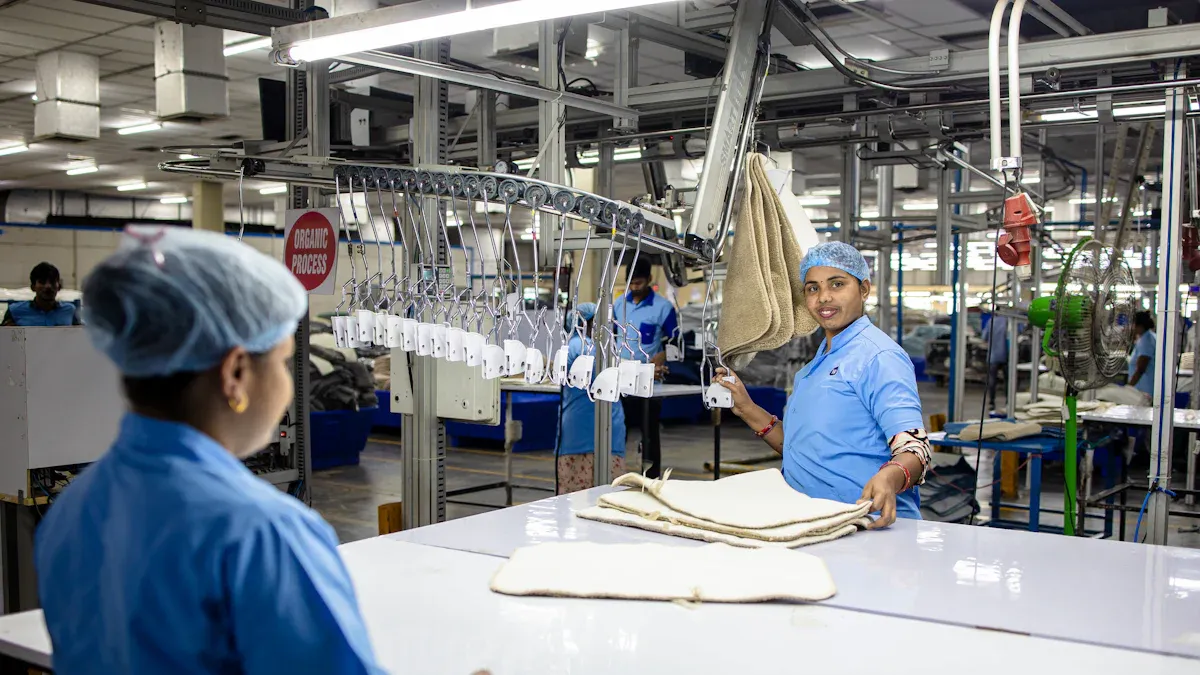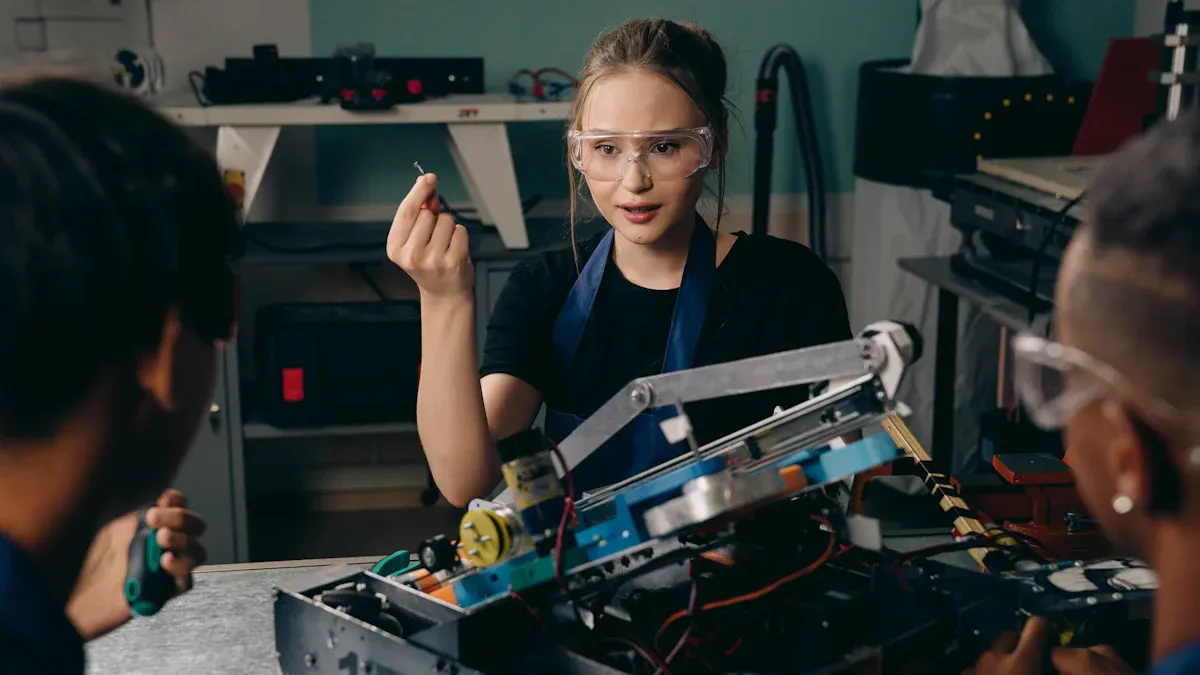How to empower teams for workforce adaptation in automated warehouses

Automated warehouses change each year. In 2024, only 25% of warehouses use automation. Experts think this number will go up to 83% by 2029. Many warehouse jobs now have new risks, highlighting the importance of workforce adaptation. The Society for Human Resource Management says 12.6% of jobs in the US could be lost. Workers need to learn digital skills and stay strong to keep up. Teams do well when people and technology work together. Leaders help teams change and grow in this fast-moving world, ensuring effective workforce adaptation.
Key Takeaways
Automation in warehouses is growing fast. Workers need to learn new digital skills to keep their jobs.
Leaders have an important job to help teams change. Good communication and support help workers trust and feel confident.
Upskilling is very important. Training often helps workers get skills for new jobs in automated places.
Let workers be part of the change. Getting them involved early and asking for feedback helps the change go better and makes workers accept automation.
Digital tools help people learn more easily. Online classes and practice with real tools help workers get used to new technology.
Workforce Adaptation Challenges

Barriers in Automation
Warehouse teams run into many problems with automation. These problems can slow down how workers adapt. They also make daily work harder. The table below lists common problems and what they cause:
Barrier Type | Description |
|---|---|
Physical Space Limitations | Buildings with low ceilings make it hard to set up automation. |
Challenges With Integration | New systems may not match old software, which can delay shipments. |
Cash Flow and Forecast Considerations | High costs mean teams must plan and spend money slowly. |
Some workers do not want change or lack skills, so training and clear talks help. | |
Scalability and Flexibility Challenges | Automation may not work well when things get busy, so flexible systems matter. |
Cyber Security and Data Integrity | Warehouses using tech face cyber risks, so strong security and staff lessons are needed. |
Small and large warehouses deal with these problems in different ways:
Barrier Type | Small Warehouses | Large Warehouses |
|---|---|---|
Financial Access | Small warehouses have less money for automation. | Large warehouses have more ways to get funds. |
Expertise | Small teams may not have experts. | Large teams often have special workers. |
Integration Challenges | Small warehouses may find it hard to connect systems. | Large warehouses have more help for smooth connections. |
Changing Roles and Skills
Automation brings new jobs and changes what skills are needed. Workers must learn new tasks and use technology. The table below shows new jobs and needed skills:
Role | Skills Required |
|---|---|
AI/Machine Learning Specialist | Machine learning, programming, data science |
Data Analyst | Data analysis, analytics tools, statistics |
Robotic Process Coordinator | Robotic systems, organization, troubleshooting |
Warehouse IT Specialist | IT support, warehouse management systems, networking |
Control Room Operator | Technical skills, quick response, problem-solving |
Robotics and Automation Technicians | Robotics, automation, mechanical know-how, problem-solving |
Automation Safety Manager | Safety standards, automated systems, attention to detail |
Robotics and Automated Systems Integrators | Warehousing, supply chain management, technology adaptation, project management |
More workers need tech skills now. They use mobile computers and smart devices. E-commerce growth means more tech workers are needed. Many old jobs now need workers to handle complex tasks and run systems. Experts say there will not be enough skilled workers. Millions of supply chain jobs may be empty by 2030.
Addressing Employee Concerns
Many workers worry about automation. Their main worries are:
Losing jobs. Many fear they will be out of work.
Not enough training. Workers feel they do not know new tech.
Automated systems breaking down. Some worry about problems and delays.
Helping workers with these worries is key for adaptation. Good ways to help include:
Get workers involved early. Let them help plan.
Talk clearly and often. Share why automation helps.
Give full training. Teach workers about changes.
Try pilot programs. Test automation in small steps.
Make sure leaders support change. Leaders must help teams adapt.
Tip: Leaders who listen and help their teams build trust and confidence when adapting to new ways of working.
Upskilling Strategies

Assessing Skill Gaps
Warehouse leaders need to know where skill gaps are. They should set clear goals for automation. These goals help teams know what to do. Leaders match these goals with learning plans. Automated surveys help leaders get feedback fast. Workers share what skills they have and what they need.
Set goals for learning about automation.
Match skill checks with current training.
Use surveys to learn about worker skills.
Experts say skills should be checked every year. Some jobs change fast and need more checks. Checking skills often helps teams get ready for new tech.
Metric Category | Specific Measures | Target Improvements |
|---|---|---|
Skill Development | Number of employees trained, proficiency in automation, certification rates | More employees skilled in automation, higher proficiency levels |
Operational Impact | Time to complete automation projects, issue resolution speed, new use cases added | Faster project completion, more automation in use |
Financial Outcomes | Cost savings, return on investment, lower consulting costs | Higher savings, better ROI, less need for outside help |
Leaders can follow steps to keep skill checks useful:
Check automation skills every few months.
Ask teams for feedback about training.
Find out what new skills are needed.
Change training and mentoring as needed.
Share wins and lessons to keep teams excited.
Tip: Sharing wins and lessons helps teams feel good and stay interested when learning new skills.
Building Digital Literacy
Digital literacy is important in automated warehouses. Workers must know how to use new devices and software. Training should teach basic computer skills and data entry. Workers also need to learn how to use mobile devices. Leaders can use online courses and games to make learning fun.
Give hands-on practice with warehouse systems.
Provide easy guides for new technology.
Let team members teach each other and share tips.
Practice and support help workers feel good using digital tools. When workers know technology, they fix problems faster. They also work better. Digital literacy helps teams get ready for changes. It makes adapting easier.
Human-Tech Collaboration
Working together with technology makes warehouses safer and better. Automation lets workers do tasks that need thinking. Robots do heavy lifting and boring jobs. This lowers the chance of getting hurt.
Aspect | Impact |
|---|---|
Productivity | Increases speed and efficiency, leading to higher output |
Safety | Lowers injury risks by automating dangerous or repetitive tasks |
Work Environment | Collaborative robots prevent injuries and create a safer workspace |
Good ways to work with technology include:
Automation helps workers do harder jobs.
Training helps workers use automated systems well.
Organizing work so people and robots use their strengths helps new ideas.
Hire and train people who work well with machines.
Give jobs to humans and robots based on what they do best.
Note: Studies show trust in technology helps human-robot teams do well. Companies that help people and machines work together see better results and happier workers.
Cobots work safely with people. They help with storing items and checking quality. This teamwork means fewer injuries and happier workers. As automation grows, working well with technology will stay important for adapting.
Implementing Adaptation Initiatives
Vision and Communication
Warehouse leaders share a clear plan for change. They tell everyone how automation helps. Teams learn that technology will help them do their jobs. Leaders use simple words to talk about new systems. They talk to workers on every shift so no one gets confused. Stakeholders join early and give their thoughts. Operators, managers, and team members work together to stop problems. Leaders build trust by listening and answering questions.
Leaders talk about how automation helps each job.
Teams get updates about changes and training times.
Workers can share ideas and worries through feedback.
All departments and shifts get the same messages.
Tip: Talking both ways helps teams feel important and ready for change.
Digital Training Tools
Digital training tools help workers learn new skills fast. Online courses, mobile apps, and games teach workers about automated systems. These tools make learning simple and fun. Workers practice with real warehouse software and devices. Digital upskilling helps workers do more and feel better at work. Teams make smarter choices on the shop floor. Companies do better when they use digital training.
Benefit | Description |
|---|---|
Increased Productivity | Digital upskilling makes workers do more work and be faster. |
Higher Job Satisfaction | Workers feel happier when they learn new skills with digital training. |
Real-time Decision Making | Digital training helps workers make smart choices right away. |
Competitive Edge | Upskilling helps companies stay ahead of others. |
Tracking Progress
Leaders check how teams are doing with new changes. They look at things like how much work gets done and how much money is saved. Leaders review results often to find and fix problems. Teams check their progress every day, week, and month. This helps everyone keep getting better. Leaders also see if workers are happy with the changes.
Metric | Description |
|---|---|
Throughput | Shows how much data is handled in a set time. |
Labor Savings | Checks if automation saves money on workers. |
Return on Investment | Looks at how much money is made from automation. |
Cash Flow | Watches money coming in and going out. |
Productivity | Checks if more work is done faster. |
Quality | Looks at how good the products or services are. |
Accuracy | Checks if work is done right. |
Consistency | Sees if work is done the same way each time. |
Reliability | Checks if systems work well all the time. |
Employee Satisfaction | Sees if workers feel good about their jobs. |
Review Frequency | Purpose |
|---|---|
Daily | Make quick changes and watch for problems. |
Weekly | Track how things are going and find trends. |
Monthly | Plan for the future and make big changes. |
Workforce adaptation works best when leaders have a plan, use digital tools, and check progress. Teams get stronger and more sure of themselves with each step.
Real-World Empowerment Examples
Case Study Highlights
VisionNav Robotics helped a drug company by adding autonomous forklifts. Workers felt safer and did less heavy lifting. The company saved money and grew bigger. Master Electronics used the AutoStore system to pick orders faster. Employees worked quicker and felt more confident. The company kept its strong culture and picked orders three times faster. These stories show automation helps teams and sets higher standards.
Absenteeism Reduction | Turnover Reduction | Productivity Improvement | Labor Cost Reduction | Overtime Hours Decrease | Order Accuracy Improvement | On-time Order Fulfillment Improvement | Employee Satisfaction Improvement | |
|---|---|---|---|---|---|---|---|---|
Pharmaceutical Distribution Center | 36% | 29% | 14% | N/A | N/A | N/A | N/A | N/A |
Automotive Parts Distribution Center | N/A | N/A | N/A | 21% | 31% | 16% | N/A | N/A |
E-commerce Fulfillment Operation | N/A | 24% | N/A | N/A | 32% | N/A | 17% | 38% |
Industry Insights
Experts say upskilling helps workers get used to automation. They see job roles changing and say learning must continue. Automation brings new jobs and better pay. Training that mixes class time and hands-on work helps workers get ready. Warehouses use AI and robots to work better and stay strong. Teams that use technology stay ahead in a fast-changing world.
Upskilling is needed to keep up with automation.
New jobs need both technical and operational skills.
Workers who learn new things get more chances.
AI and robots help warehouses work faster and smarter.
Practical Takeaways
Warehouses use many tools to help teams change. Pick-to-Light uses lights to show workers where to pick items. This makes picking faster and more correct. Put-to-Light shows where to put things, so there are fewer mistakes. Robotic picking uses machines to move items and speed up work. Voice-directed systems give spoken directions, making work safer and more accurate. Automated conveyors and inventory drones help move goods and count stock. Barcode systems track items and help stop mistakes.
Technology Type | Description | Benefits |
|---|---|---|
Pick-to-Light (PTL) | Lights guide workers to products | Faster picking, better accuracy |
Put-to-Light | Lights show where to place items | Fewer mistakes, quicker sorting |
Robotic Picking | Robots move and identify items | Less manual labor, higher efficiency |
Voice-Directed Systems | Spoken instructions for tasks | Safer work, more accurate picking |
Automated Conveyor | Moves goods using barcodes or RFID | Less manual handling, higher throughput |
Inventory Drones | Cameras count and check inventory | Better accuracy, lower labor costs |
Barcode Systems | Labels for tracking and faster workflows | Fewer errors, improved efficiency |
Teams face problems like worrying about job loss and not having enough tech skills. Good training, clear talks, and flexible teams help. Companies that include workers in changes do better. Workforce adaptation works best when leaders help teams and support learning.
Note: Almost 60% of warehouse workers worry about automation. Companies that include workers in changes do 40% better.
Warehouse teams do well when leaders help people and robots work together. Training helps workers learn new skills and feel happy at work. Digital literacy lets workers use new tools and do jobs better. Leaders can plan time for learning and practice drills. They can also update how work gets done. When leaders talk clearly and help, workers want to learn new things. Strong teams change fast and do well with automation.
Help people and technology work as a team
Set aside time for learning and cross-training
Tell all shifts about changes in simple words
Leaders who help their teams make workers feel sure and help them do well in automated warehouses.
FAQ
What skills do warehouse workers need for automation?
Warehouse workers need digital literacy and problem-solving skills. They also need basic computer skills. Workers learn to use mobile devices and automated systems. Training helps them work with robots and new technology.
How can leaders help teams adapt to automation?
Leaders set clear goals for their teams. They give regular training to workers. Leaders listen to what employees worry about. They share updates with everyone. Leaders encourage teamwork between people and technology.
Why do some workers worry about automation?
Many workers are afraid of losing their jobs. Some do not understand new technology. They worry that systems might break down. Leaders help by talking openly and giving support.
What digital tools help with workforce adaptation?
Digital tools include online courses and mobile apps. Simulation games also help workers learn. These tools teach about automated systems. They help workers practice new skills.
How do companies measure success in workforce adaptation?
Metric | Description |
|---|---|
Productivity | Measures how fast work gets done |
Employee Satisfaction | Tracks if workers feel happy |
Accuracy | Checks if tasks are done right |
Tip: Companies look at these numbers often to get better results.
See Also
The Future Lies in AI-Driven Retail Solutions
Revolutionizing Online Store Management with AI Tools
Boosting Office Efficiency Using Intelligent Vending Machines
